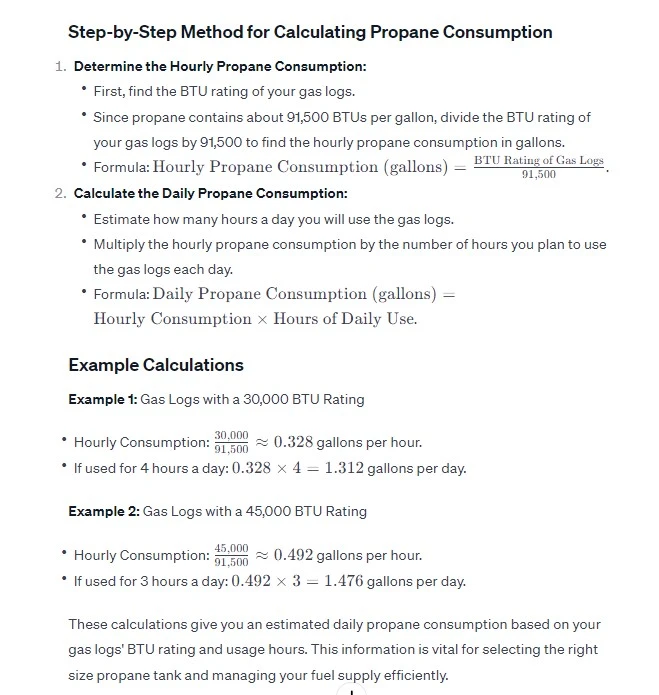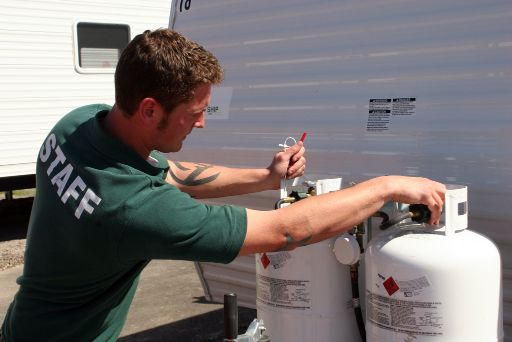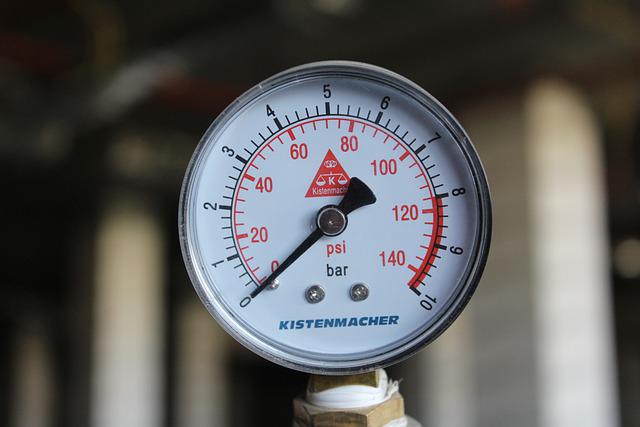
The size of the propane tank you need for gas logs depends on several factors, including the BTU rating of your gas logs, how often you plan to use them, and whether you’ll be using propane for other appliances as well. Here’s a general guideline to help you determine the right size:
- Determine the BTU Rating of Your Gas Logs: Check the specifications to find out their BTU (British Thermal Unit) rating. This measures the amount of heat required to raise the temperature of one pound of water by one degree Fahrenheit. Gas logs typically range from 20,000 to 90,000 BTUs.
- Calculate Daily Propane Consumption: Propane’s energy content is approximately 91,500 BTUs per gallon. To calculate how much propane your gas logs will use per hour, divide their BTU rating by 91,500. Multiply this by the number of hours you plan to use the appliance each day to estimate daily consumption.
- Consider Usage Frequency: If you plan to use the appliance frequently or as a primary heat source, you’ll need a larger tank than if you’re using it occasionally.
- Other Appliances: If you’re using propane for other appliances (like a water heater, stove, or furnace), you need to factor in their consumption as well.
- Tank Size Options: Residential propane tanks come in various sizes, commonly ranging from 20 pounds (5 gallons) to 1,000 gallons. For occasional use of the appliance, a smaller tank (like 100 or 250 gallons) might suffice. For more frequent use or multiple appliances, consider larger tanks (500 or 1,000 gallons).
Remember, these are general guidelines. Your actual needs may vary based on usage patterns and specific equipment requirements.
Determining Your Gas Logs’ BTU Rating
To determine the BTU rating of your gas logs and understand its impact on propane consumption, follow these steps:
- Finding the BTU Rating of Your Gas Logs:
- Check the User Manual: Usually, the BTU rating is listed in the user manual that comes with your gas logs.
- Look for a Label or Plate: Often, the appliance has a label or metal plate attached to them which includes the BTU rating.
- Contact the Manufacturer: If you can’t find the BTU rating, contact the manufacturer with your model details.
- Understanding the Correlation Between BTU Rating and Propane Consumption:
- Higher BTU Means More Propane: The higher the BTU rating, the more propane your gas logs will consume. BTU measures the amount of heat your gas logs produce. More heat requires more fuel.
- Calculate Propane Needs Based on BTU: You can estimate how much propane the appliance will use by understanding their BTU rating. The formula is straightforward: the propane usage per hour in gallons is equal to the BTU rating divided by 91,500 (the BTU content of a gallon of propane).
Knowing the BTU rating of your gas logs is crucial for choosing the right size propane tank and ensuring efficient fuel use.
Calculating Propane Consumption for Gas Logs
Calculating the daily propane consumption for your gas logs involves a few simple steps. Here’s a step-by-step guide, along with example calculations for clarity:

Propane Tank Size Options
When it comes to propane tanks, there’s a wide range of sizes available to suit different needs. Here’s an overview of common tank sizes and recommendations for various usage scenarios:
| BTU Rating | 20 Gallon Tank | 100 Gallon Tank | 250 Gallon Tank | 500 Gallon Tank | 1000 Gallon Tank |
|---|---|---|---|---|---|
| 10,000 BTU | 183 hours | 915 hours | 2,287.5 hours | 4,575 hours | 9,150 hours |
| 20,000 BTU | 91.5 hours | 457.5 hours | 1,143.75 hours | 2,287.5 hours | 4,575 hours |
| 40,000 BTU | 45.75 hours | 228.75 hours | 571.88 hours | 1,143.75 hours | 2,287.5 hours |
| 60,000 BTU | 30.5 hours | 152.5 hours | 381.25 hours | 762.5 hours | 1,525 hours |
* Estimated Duration for Standard BTU Gas Logs: The actual duration each tank size will last depends on the BTU rating of your gas logs and how frequently you use them. Higher BTU ratings and more frequent use will deplete the tank faster. It’s recommended to calculate your specific needs based on your gas logs’ BTU rating and daily usage.
Recommendations for Different Usage Scenarios
- Occasional Use (e.g., decorative purposes): A smaller tank (20-100 gallons) might be sufficient.
- Regular Use (e.g., primary heating source): Consider a medium-sized tank (100-500 gallons).
- Multiple Appliances or High Heating Demands: A larger tank (500-1,000 gallons) is recommended.
- Commercial or Extensive Residential Use: Look into tanks larger than 1,000 gallons.
Additional Considerations
- Space and Aesthetics: Larger tanks require more space and may need to be installed underground for aesthetic reasons.
- Local Regulations: Always check local codes and regulations regarding propane tank installation.
- Professional Consultation: It’s advisable to consult with a propane supplier or professional for personalized recommendations based on your specific needs and usage patterns.
Selecting the right propane tank size ensures efficiency, safety, and uninterrupted fuel supply for your gas logs and other propane appliances.
Consumption and the Length of Time You Want to Operate the Gas Logs, Play a Crucial Role
in order to determine the appropriate size propane tank for your gas logs, it is important to know the rate of LPG (propane) consumption and the length of time that you intend to operate the appliance. The rate of consumption is measured in BTU (British Thermal Units) per hour, and this information can typically be found on the manufacturer’s specifications or by consulting with a professional. The length of time that you intend to operate the gas logs will also play a role in determining the size of the tank needed.
For example, if you have a gas log set that consumes 40,000 BTU per hour and you plan to operate it for 8 hours a day, then you’ll need a tank that can hold at least 320,000 BTU of propane. Depending on the climate, you may need to run the appliance for longer periods of time.
It’s also important to consider the weather conditions in your area and how they may affect the consumption of propane. For example, if you live in an area with colder winters, you may need to run the appliance more frequently and for longer periods of time to keep your home warm, which will increase the consumption of propane.
Determining the right size propane tank for your gas logs requires knowledge of the LPG consumption rate in BTU per hour and the length of time that you intend to operate the appliance, as well as the climate conditions of your area. It’s recommended to consult with a professional or the manufacturer of the appliance to determine the specific size of tank needed for your setup.
Take Into Account Weather Conditions and How They May Affect Consumption
When determining the appropriate size propane tank for gas logs, it’s important to take into account the weather conditions in your area and how they may affect consumption. For example, if you live in an area with colder winters, you may need to run the gas logs more frequently and for longer periods of time to keep your home warm, which will increase the consumption of propane. Similarly, if you live in an area with hot summers, you may need to run the air conditioning more often, which may also increase the consumption of propane.
Additionally, you should also consider the wind, rain, and snow, since they all can affect the combustion process and increase the consumption of propane. For example, windy weather can cause the flame to flicker, which can lead to an increased consumption of propane. Rain and snow can also cause the flame to flicker, and in some cases, can even extinguish the flame altogether.
Consult With the Manufacturer or a Professional
Consulting with the manufacturer or a professional is an important step in determining the appropriate size propane tank for your gas logs. The manufacturer of the gas logs can provide you with detailed information on the LPG consumption rate (measured in BTU per hour) and the recommended size of the propane tank that is needed to operate the logs. This information can be found in the owner’s manual or on the manufacturer’s website.
A professional, such as a licensed gas contractor or propane supplier, can also help you determine the appropriate size propane tank for your appliance. They will be able to take into account your specific circumstances, such as the size of your home, the number of gas logs, and the weather conditions in your area, to recommend the appropriate size tank for your needs. They can also advise you on the best location for the tank, the safety measures that need to be taken, and the cost of installation, maintenance and inspection.
In Conclusion
Determining the appropriate size propane tank for your gas logs is important to ensure that you have enough propane to keep your home warm and comfortable throughout the year. Factors such as the rate of LPG consumption, the length of time the gas logs will be operated, and weather conditions in your area all play a role in determining the size of the propane tank needed. Consultation with a professional or the manufacturer can provide you with a more accurate estimate of the appropriate size propane tank.
It is important to take into account safety measures, proper ventilation, and regulations and codes when choosing the location for the propane tank. The cost of propane tanks and maintenance is also an important aspect to consider before making a decision. By taking all of these factors into account, you can ensure that you have the appropriate size propane tank for your appliance and can enjoy a warm and comfortable home all year round.

Mike is an experienced propane technician with over 15 years of professional experience in the field. He has dedicated his career to helping customers with their propane needs, from installation to maintenance and repair. Together with Jeremy, he co-founded this website to provide useful information and guidance to customers seeking reliable propane services.



